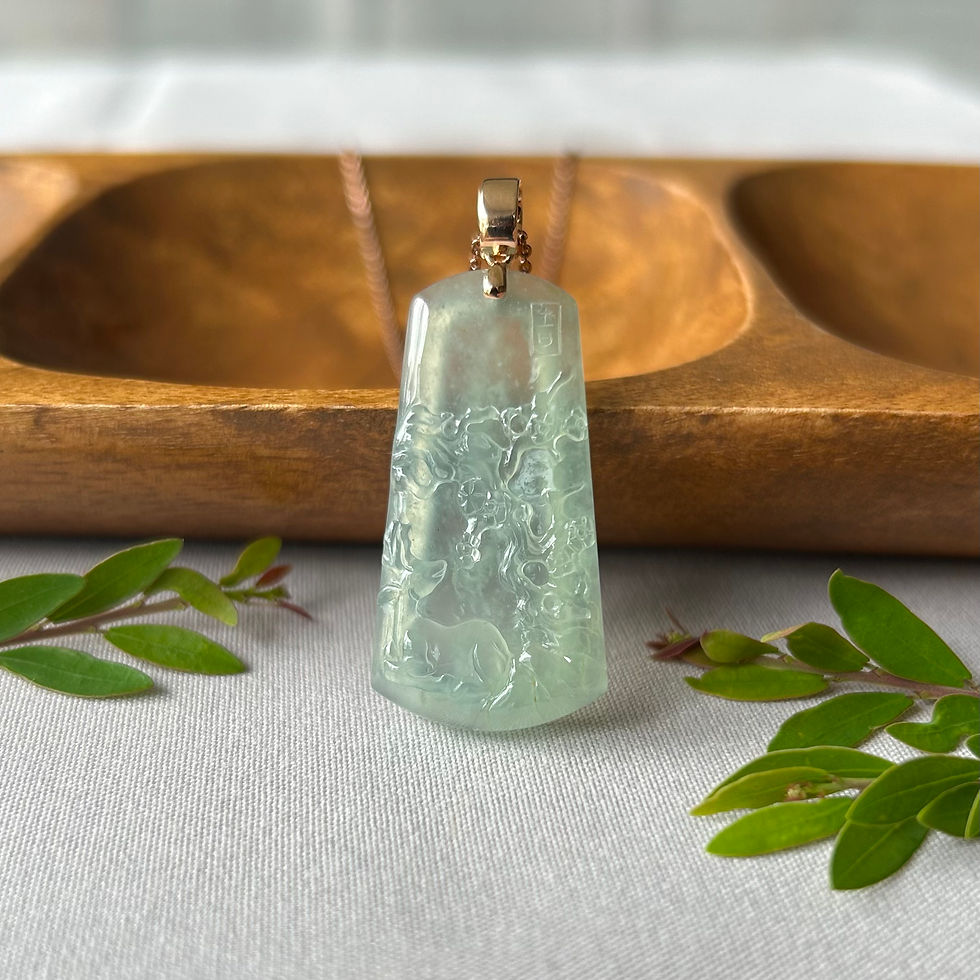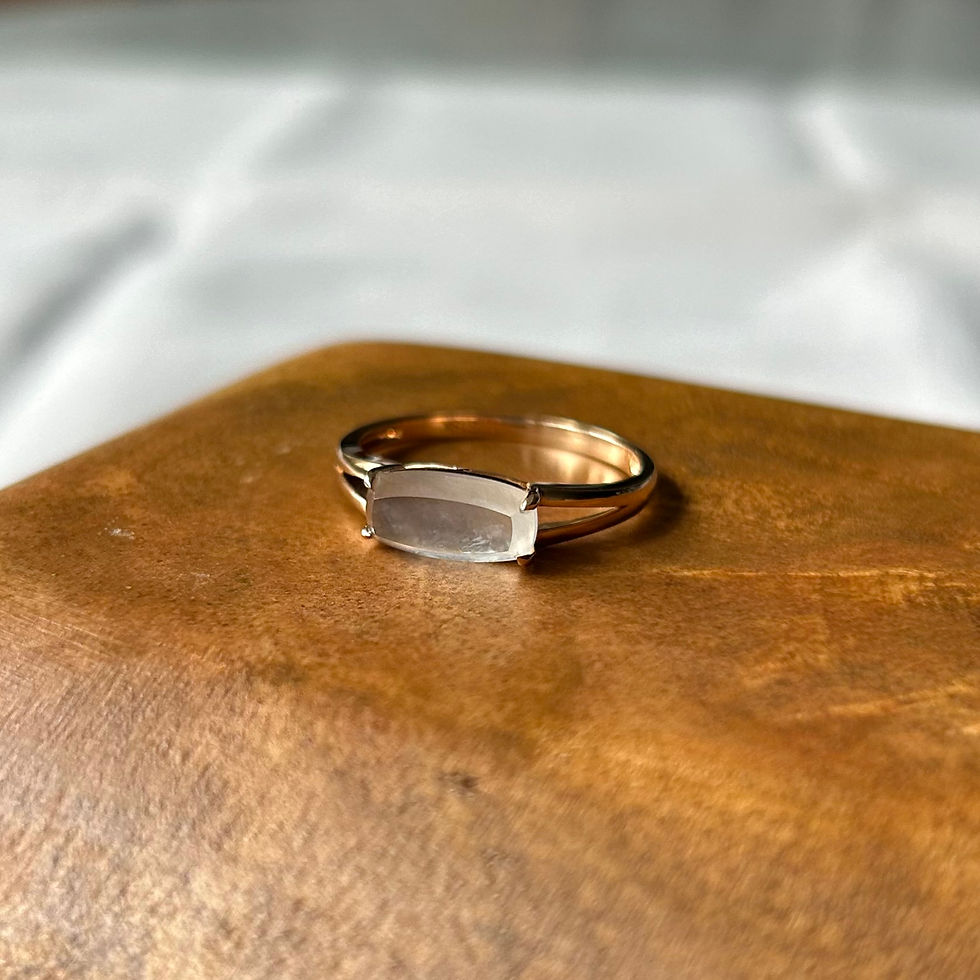‘Zhong’ or Grain: The Soul of Jadeite?
- Bryson Lam
- Dec 4, 2024
- 4 min read
Updated: Jan 30

Our iris purple cabochon ring, a fine-grained and highly translucent piece that stands out from the crowd.
Jadeite traders always say: 种是翡翠的灵魂 (‘zhong’ or ‘grain’ is the soul of jadeite). What does that mean and why do they say that? In this post, we will go into:
The different grains of jadeite
Why that is important to a piece of jadeite’s aesthetic value, and
How market value is affected as a result.
TLDR: Grain (种) is a matter of fineness; the finer the grain, the more translucent jadeite is, though there are exceptions. This forms the foundation of the aesthetic allure of jadeite.Note: This article features products that may or may not be listed for sale at our store. Enquire for more details.
The Soul of Jadeite?
It might be a strange claim to say the grain is the soul of jadeite. (Doesn’t help that in the jadeite world there are so many sayings that don’t make much sense to the outside world.) So, what are they trying to say?
What it means is that the grain forms the foundation of the aesthetic allure of a jadeite piece: the finer the grain, the more aesthetically pleasing they are.
How this works is that finer-grained pieces are firstly clearer and more translucent, which creates depth, sometimes glow and a three-dimensional effect as it lets light through. Secondly, they have less visible (but not completely absent) crystalline structures that create a more pleasant appearance that does not fatigue over time. As such, fine-grained jadeite appears to be more ‘alive’ compared to coarse-grained pieces that appear dull and the appeal remains on the surface level.

Our bright turquoise faceted cut ring makes a strong and lasting impression not just for its refreshing colour, but also its fine grain that gives it depth and allure.
The Fineness of Grain on a Spectrum
Next, how do we tell the grain of jadeite? Actually it isn’t that challenging: what’s most important is to pay attention to the fineness of grain (not translucency - more on the difference later).
Coarse-grained jadeite (豆种 or ‘bean-like’ grain) have obvious crystalline structures. Much like beans where you can see clearly each individual bean, in coarse-grained jadeite you can see the crystals clearly. Such coarse-grained jadeite tend to have low market value, are typically sold by batches in Sihui (四会) City in Guangdong, China and carved by machine.

A jadeite wholesale market in Sihui (四会) City, Guangdong, China. Photo from Xiaohongshu.
Less coarse-grained jadeite are known as 糯种 or ‘glutinous-like’ grain. As the name suggests, such jadeite have the grain of glutinous congee, where the crystalline structures are visible but smoother and less coarse.
This category is very broad: from 粗糯 (coarse glutinous) to 糯 (glutinous), and 细糯 (fine glutinous) to 糯冰 (icy glutinous), they simply describe the fineness of grain, much like how thick or watery glutinous congee can be. No need to split hairs over them though - when shopping for pieces, compare various pieces and evaluate the grain for yourself.

A fine glutinous (细糯) lavender bangle [NGI-certified].

An icy glutinous (糯冰) sugary yellow Goddess of Mercy pendant.
Next is the most widely used (as well as most misused) term which is ‘icy’ or 冰种. Again, as the name suggests, the grain of icy jadeite should be considerably fine that it has the translucency of ice. That said, it also has a range: whether it is 嫩冰 (somewhat icy), 正冰 (icy) or 高冰 (highly icy), it depends on the amount and visibility of 棉 (or ‘cotton’, the opaque white parts that are naturally occurring in jadeite) that obstructs translucency.

An icy (正冰) deer pendant in 18K rose gold.

A highly icy (高冰) goldfish pendant.
‘Glassy’ jadeite (玻璃种) is the most fine-grained of all. It is so fine that it has a glass-like quality, where the ‘cotton’ is so fine and so dispersed it becomes almost transparent. This is most apparent in white jadeite. However, as ‘cotton’ is naturally occurring, it is untrue to say that glassy jadeite has zero cotton at all. Under strong lighting, the ‘cotton’ should still be visible.

A glassy oval cabochon ring that is almost transparent and only has little specks of 'cotton' (棉) visible.
Difference between Grain and Translucency
After all that’s said, doesn’t it seem like grain simply refers to how translucent or opaque a piece of jadeite is? Why so complicated then?
That’s because that claim is only partially correct: grain is indeed correlated to translucency i.e. the more fine-grained, the more translucent. However, there are exceptions where finer-grained pieces are less translucent, or coarser-grained pieces are more translucent.
Take for example the ‘waxy’ (胶 which literally means ‘glue’ or ‘gum’) category of jadeite. Waxy jadeite is termed as such as it is very fine-grained, such that the crystalline structure is not apparent, but has a cloudy look that leads to reduced translucency. Compared to highly icy jadeite it is less translucent, but is considered more fine-grained. (More on waxy jadeite in a later post.)

Waxy jadeite, like this landscape pendant with olive green streaks, may not be as translucent as icy jadeite, but is valued for its exceptionally fine grain.
Is my Jadeite Soul-less?
Ultimately, how do all these affect buyers? From your perspective, taking into account your budget, we recommend all clients to go for finer-grained pieces (肉质细腻 or 种老肉细), even if they might not be as translucent. This is because fine-grained pieces are less susceptible to oxidation (变种) and are highly appreciated for its beauty and allure, even if they may sometimes lack that icy translucency jadeite collectors so desire. Coarse-grained jadeite certainly still has value as an accessory, but we also want to help clients deepen their understanding and appreciation of jadeite.
At the end of the day, love and take care of your pieces, and each piece, whatever the grain or quality, will be a treasured gem for generations to come.

A glassy saddle ring, a fine example of 种 (grain) in jadeite.



Comments